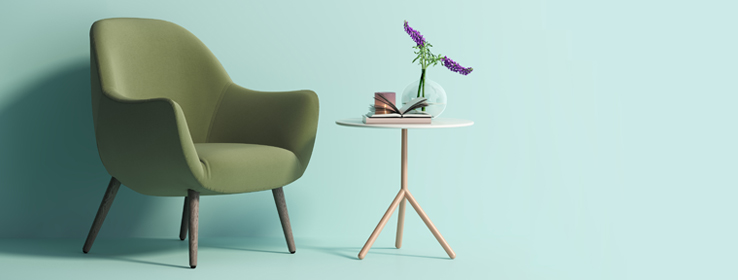Forget “white cube” rooms — color experts share how to use color and bold elements in minimalist designs for residential and commercial spaces.
by Megan Swoyer
If there’s one phrase that could sum up approach to lifestyle and culture in 2017, it’s “less is more.” Whether it’s embracing minimalist or Scandinavian design, mid-century modern, empty-nesting, hopping on the Marie Kondo tidy-living craze or welcoming the tiny-house boom, designers’ clients are seeking to transform their lives by living with less.
But designing a minimalist space doesn’t mean everything has to be awash with basic whites and clean lines. In fact, color experts say color is a tool that helps enhance these spaces and create more organized, streamlined surroundings that inspire mental clarity.
“How you use color in a minimalist space is super important because when people are in a minimal space, they have the capacity to focus on color,” says Chicago-based color psychologist Dr. Sally Augustin. “When creating a minimalist space, don’t underestimate color. It’s just as stressful — even scary and overwhelming at times — to be under-stimulated by a lack of color as it is to be over-stimulated by too much color or pattern.”
Augustin, who specializes in environmental psychology, suggests using non-saturated hues for clean-lined, non-fussy environments.
“With wall colors, go with tints of colors,” Augustin says. “Tints will prevent people from numbing out to such an extent that it’s unpleasant.”
Augustin likes to remind designers — both commercial and residential — that when we’re under-stimulated, our brain can become unproductive and almost compulsive. For example, if you’re in your office surrounded by a lack of color, you may ask yourself, “Did I turn the stove off this morning? I wonder how long the washer’s been running?” Rather than remaining focused on the task at hand.
Minimalist environments for older homeowners, hospital patients or residents of senior living facilities also require a keen use of color. Many small rooms in hospitals, although often jammed with medical equipment, feature a more minimal design these days, along with a thoughtful use of color.
“When people wake up — whether at home or in a hospital bed — their minds can be a bit foggy, making it difficult to reorient themselves. But if there are gradations of color, with darker tones underfoot and lighter shades overhead, it’s easier to get your bearings,” Augustin says.
Jump to section
Color Inspires Creativity: Color and office design
Color, Color Everywhere: Color and organization
Rooms With a View: Color and commercial design
Color Inspires Creativity
For those who live or work in creative environments but still prefer a minimal approach to design, designer Elin Walters of Exactly Designs in Ann Arbon, Michigan, always veers toward pops of color.
“I find color to be absolutely refreshing, clean and alive. I find that energy is created where color exists. Without it, a space can be rather lifeless.”
Walters recently created a home office that showcases a trio of shades: “I’ve been obsessed with the color mint green this season and that became the launching pad to create the office space. Mint is on the walls, with neutral furnishings for balance, plus a contrasting pop of pink to draw the eye.”
Like Walters, color psychologist Augustin’s energy boost also comes in waves of green.
“Different shades of green enhance creative thinking,” Augustin says. “If you’re in a space where the walls aren’t saturated but are bright, like with a sage green, you’ll feel positive and relaxed, and inspired to create.”
Try:


Return to Top
Color, Color Everywhere
Karrie Hodge, senior designer and new-residential specialist for Sherwin-Williams, recommends utilizing color throughout residences that feature minimalist spaces.
“Start with a neutral base throughout the house and then add color to specific rooms that you want to feature as an accent,” Hodge says. “In those rooms, you can add an accent wall or the whole room can be colorful.”
Hodge, who prefers to choose paint colors last when designing a space, likes the Sincerity palette from the 2018 Colormix® Color Forecast because it “plays up to that minimalist, less-is-more feel — it has some nice colors that are both light and dark. Pearl Gray is a light blue-ish green with just a hint of color, which evokes relaxation and simplicity.”
Hodge also suggests using color to organize spaces. Take a shelving unit, for example. Here, one might color-coordinate each shelf (as opposed to putting color on the wall). One shelf could be blue for office supplies, one could be gray for books and so on, “which ends up looking cool,” Hodge says.
Like Hodge, Walters suggests using repeating colors throughout the home. “My colors repeat, but not in an obvious way. For example, the cabinets in the kitchen are a soft turquoise and that same shade is seen again on a wall in a completely separate part of the house. This is my way of providing continuity, flow, ease and order, which all enhances my minimally styled home.”
As for accessories and wall paint, professional organizer Lauren Combs of Neat Method, which has offices throughout the United States, suggests keeping colors together. “If a client has blue accessories, organize and group them together and paint your accent wall a color within that family,” Combs says.
Try:


Return to Top
Rooms With a View
Emily Kantz, healthcare and hospitality color specialist for Sherwin-Williams, is big on tinted neutrals. “Tinted colors are soft and very faint — they’re what I like to suggest for minimal space designers who want to add color. It’s a Scandinavian look.”
When designing for hospitals or hotels, Kantz thinks about the overall facility, from lobbies to hallways to patient or hotel guestrooms. “I take flooring, surfaces and wall colors all into consideration and will often use a great neutral base and then play off it, using it throughout the facility,” Kantz says. “So a hotel lobby or suite will have certain wall colors and then the guestroom itself might be the same color family, but a softer tone.”
Kantz believes bold colors and strong jewel tones certainly have a place, especially when designing spaces that require wayfinding. For example, a parking garage can handle bold color in small doses for marking spaces or floors. Users will normally remember, “I parked on the purple floor,” Kantz explains, and not the off-white or beige-toned floor.
Like Hodge, Kantz waits until the end of the design process to choose her colors. “Paint is the last thing I consider — it’s always the icing on the cake.”
Try:


Return to Top





